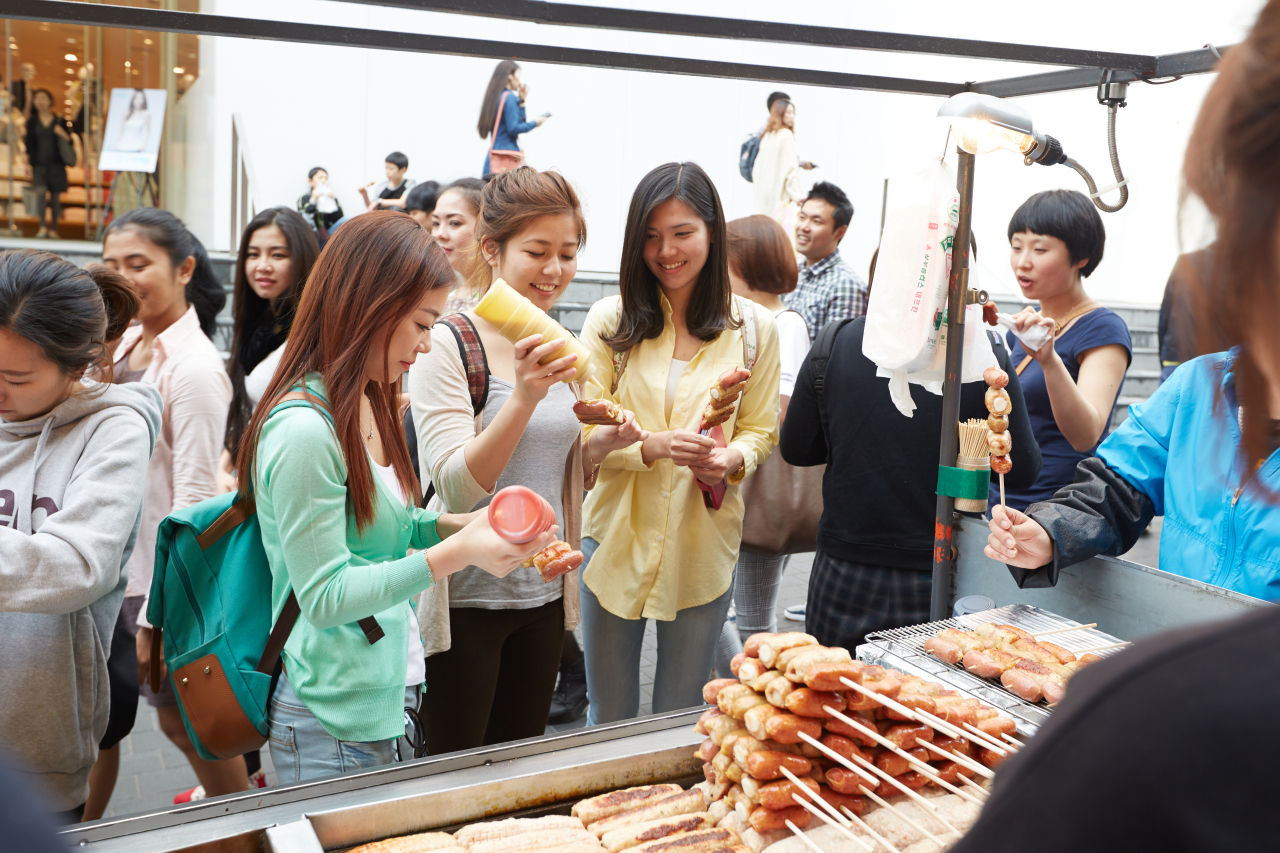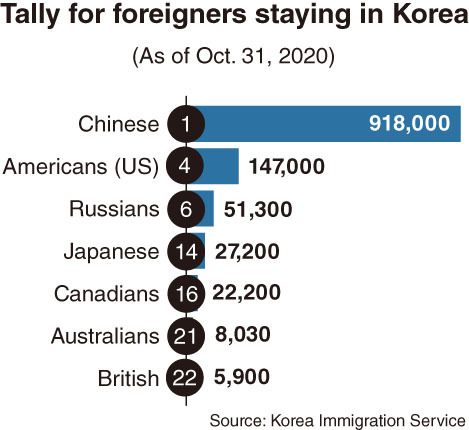
Tourists from abroad try food at a street stall in Seoul. (Korea Tourism Organization)
SEJONG -- The tally of foreigners staying in South Korea -- both as long-term residents and short-term visitors -- has dropped to its lowest point in about three years amid the pandemic. Previously it climbed 116 percent in a decade, from 1.16 million in 2009 to 2.52 million in 2019.
According to the Korea Immigration Service, the number of foreigners staying in Korea posted 2.07 million as of October 2020. It was 2.18 million in December 2017 and 2.04 million in December 2016.
The 2020 figure marked a 17.7 percent decline in only 10 months, meaning there were 447,603 fewer foreigners than 2.52 million at the end of 2019.
Chinese nationals still accounted for the greatest proportion of the total, with 918,000 Chinese people staying in Korea as of October 2020, though the figure slid by 16.5 percent from 1.1 million in December 2019 due to COVID-19. Ethnic Koreans from China -- Chinese citizens of Korean descent -- made up more than 70 percent (663,000) of the 918,000 Chinese here.
Vietnamese and Thais were next most numerous, respectively accounting for 211,000 and 184,000 people. Many of these were laborers or wives of Korean men who had extended their stay here, while others chose to visit despite the pandemic.

(Graphic by Kim Sun-young/The Korea Herald)
US nationals accounted for 147,000 people, including about 28,500 US military troops stationed here, constituting the fourth-most-numerous group. Next were people from Uzbekistan at 66,900, Russians at 51,000, Philippine nationals at 50,500, Mongolians at 42,000, Nepalese at 40,400 and Indonesians at 37,400. Next were those from Kazakhstan at 29,800 and those from Myanmar at 27,500.
While the tally of visitors declined 17.7 percent, the number of Japanese visitors showed a noteworthy drop over the corresponding 10-month period.
In December 2019 there were 86,100 Japanese nationals in Korea, and the country was No. 5 in terms of numbers of expatriates staying in the nation. But it had fallen to No. 14 as of October 2020 with just 27,200 Japanese staying here, representing a 68.4 percent decline.
Alongside the COVID-19 situation, the sharp decrease in the number of Japanese in the nation could be the result of a diplomatic feud between Seoul and Tokyo, which impeded the marketing and sales activities of Japanese businesses here.
The drop was particularly marked among short-term visitors -- those with permission to stay in Korea for no more than 90 days. That figure declined 44.3 percent from 792,853 in December 2019 to 441,132 in October 2020.
The number of long-term visitors (people staying 91 days or longer) declined 5.5 percent, from 1.73 million to 1.63 million.
Nonetheless, past data suggests that the tally could rebound rapidly when the world sees a certain level of normalization after the pandemic.
After topping the 300,000 mark for the first time in 2012, the number of short-term inbound visitors continued to increase, exceeding 500,000 in 2016 and approaching 800,000 in 2019.
The trend for long-term visitors was the same -- from 1.12 million in 2012 to 1.53 million in 2016 and approaching 1.8 million in 2019.
The average age of foreigners in Korea remained under 40, while the average age of South Koreans had reached 43.1 years as of October 2020.
Visitors in their 30s were the most numerous at 27.3 percent (567,030) of the 2.07 million total for both short- and long-term stays.
Expatriates in their 20s made up 22.7 percent (472,400) of the total, followed by those in their 40s at 16.4 percent (341,443) and those in their 50s at 14.8 percent (306,868). Those aged 60 or over and those under 20 accounted for 12 percent (252,220) and 6.7 percent (139,092), respectively.
By Kim Yon-se (kys@heraldcorp.com)







![[KH Explains] How should Korea adjust its trade defenses against Chinese EVs?](http://res.heraldm.com/phpwas/restmb_idxmake.php?idx=645&simg=/content/image/2024/04/15/20240415050562_0.jpg&u=20240415144419)